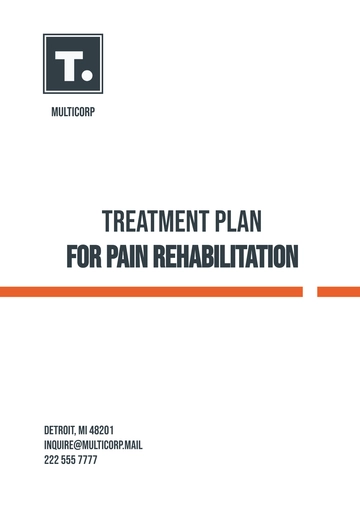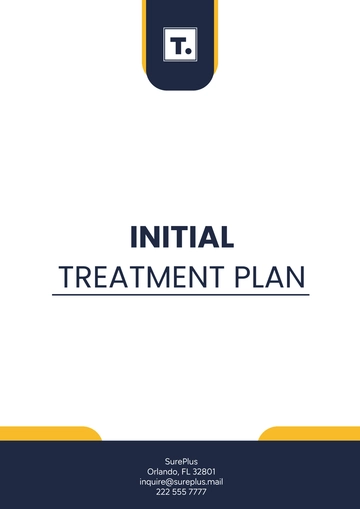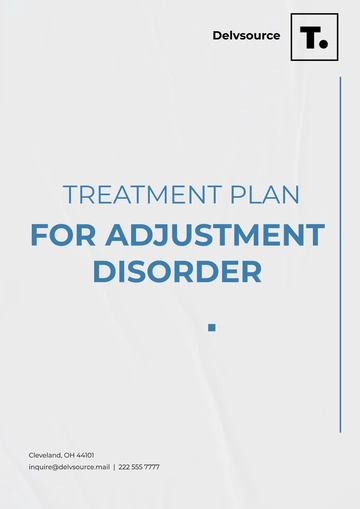Free Chiropractic Clinic Treatment Plan

Prepared by [Your Company Name]
Effective Date: [2050]
I. Introduction
A. Purpose of the Treatment Plan
The Chiropractic Clinic Treatment Plan is a personalized and strategic approach aimed at achieving long-term musculoskeletal health, pain relief, and overall wellness. The plan details each step in the treatment process, from initial consultation to long-term maintenance, ensuring that the patient receives optimal care tailored to their specific needs. By addressing the root causes of the patient’s discomfort, this plan helps to enhance mobility, reduce chronic pain, and improve spinal health.
The chiropractic approach focuses on aligning the spine and improving body function without invasive treatments, such as surgery or medications. This holistic plan not only aims to treat immediate symptoms but also works to improve the patient’s overall lifestyle, posture, and movement patterns for a healthier future. Regular progress evaluations and adjustments to the treatment approach are integral to ensuring that the treatment remains effective and adaptive to the patient’s needs over time.
II. Patient Information and Assessment
A. Patient Demographics
To establish a comprehensive treatment plan, it is essential to collect detailed demographic and medical information. This ensures that the treatment plan is tailored to the individual’s specific health profile. The following data points are essential:
table:
Patient Information | Details |
|---|---|
Name: | [Patient's Full Name] |
Age: | [Patient's Age] |
Gender: | Male |
Address: | [Patient's Address] |
Phone Number: | [Patient's Contact Number] |
Email: | [Patient's Email Address] |
Date of Initial Consultation: | 2050-12-05 |
This information provides a baseline for understanding the patient’s general health, potential medical risks, and the possible impact of certain treatments based on their age, lifestyle, and medical background.
B. Presenting Complaints
The presenting complaints provide critical insight into the nature of the patient's condition. This information is collected through detailed consultations where the chiropractor listens to the patient’s description of their symptoms. Common complaints might include:
Neck Pain: Often caused by poor posture, stress, or past injuries. Neck pain can also be a symptom of disc issues or spinal misalignment.
Back Pain: Often linked to poor posture, muscle strain, or trauma. Chronic back pain may be caused by conditions such as herniated discs, scoliosis, or degenerative disc disease.
Headaches: Tension headaches are frequently associated with neck stiffness or upper back misalignments. Migraines may also be alleviated through spinal adjustments.
Sciatica: Pain radiating down the leg, often caused by a herniated disc, can be managed with decompression therapy or spinal manipulation.
The chiropractor will inquire in detail about the location, severity, frequency, and duration of the pain to determine the best course of action. These questions help in tailoring treatment to achieve the best possible results for the patient’s unique needs.
C. Medical History
A comprehensive understanding of the patient’s medical history is crucial to determining a safe and effective treatment plan. Relevant medical history might include:
Past injuries or surgeries: Injuries such as fractures, sprains, or past surgeries (especially spinal surgeries) will inform the chiropractor of the patient's tolerance to certain treatments and whether certain techniques should be avoided.
Chronic Conditions: Conditions like arthritis, osteoporosis, or fibromyalgia may complicate or influence the treatment approach. For example, osteoporosis may require gentler techniques and extra caution.
Current Medications: Some medications, such as blood thinners or painkillers, can interfere with chiropractic care. It is essential to understand the patient’s current medication regimen to avoid complications.
Lifestyle Factors: The chiropractor will inquire about the patient’s daily routine, including any postural habits, stress levels, exercise habits, and work environment. For example, a patient who works at a desk all day may benefit from ergonomic recommendations or specific stretching exercises.
D. Diagnostic Tests and Findings
Diagnostic testing is vital to understand the condition thoroughly. It helps confirm the chiropractor’s initial findings and rule out any other conditions that may not be directly treatable through chiropractic care. This may include:
Physical Exam: The chiropractor will perform a thorough physical assessment to test muscle strength, joint mobility, and flexibility. Special tests for conditions such as disc herniation or nerve impingement may be used.
Imaging Tests: If needed, X-rays, MRIs, or CT scans may be ordered to detect structural issues like misalignments, herniated discs, or degenerative changes in the spine. Imaging is especially useful when the chiropractor suspects a more serious underlying condition.
Functional Assessments: These assessments help determine the impact of the patient’s symptoms on daily life. These may include tests of flexibility, posture, balance, and strength to assess how well the patient performs routine tasks.
III. Treatment Plan
A. Treatment Phases
1. Initial Phase: Symptom Relief
Duration: [2-4] weeks
Frequency: [3] sessions per week
The first phase of the treatment plan focuses on immediate pain relief and addressing acute symptoms. The goal is to reduce discomfort and start the healing process, which prepares the patient for more advanced interventions in later phases.
Goals:
Reduce pain and inflammation quickly.
Alleviate muscle spasms and tension.
Begin correcting spinal misalignments and restore some degree of motion.
Treatment Techniques:
Spinal Adjustments: Spinal manipulations are performed to relieve nerve compression and reduce inflammation. These are typically done gently at the beginning to avoid exacerbating any acute issues.
Soft Tissue Therapy: Techniques like myofascial release and deep tissue massage can help release muscle tightness and alleviate muscle-related pain.
Ice/Heat Therapy: Ice therapy is used to reduce swelling and inflammation, while heat therapy is applied to relax muscles and improve blood circulation.
Electrical Stimulation: Low-level electrical pulses are used to reduce pain, relax muscles, and stimulate healing of damaged tissues.
2. Corrective Phase: Address Root Causes
Duration: [4-8] weeks
Frequency: [2] sessions per week
Once the pain has been reduced in the initial phase, the focus shifts to addressing the underlying causes of the symptoms. This phase works to realign the spine, restore proper movement, and reduce the risk of further issues.
Goals:
Correct spinal misalignments.
Strengthen the muscles around the spine and joints.
Enhance overall function and mobility.
Treatment Techniques:
Advanced Spinal Adjustments: Adjustments become more targeted and specific during this phase, aimed at realigning misaligned vertebrae and improving joint mobility.
Postural Exercises: These exercises help retrain the body to maintain proper posture and avoid repetitive strain.
Rehabilitation Exercises: Focus on strengthening core muscles, improving flexibility, and stabilizing the spine.
3. Maintenance Phase: Long-Term Wellness
Duration: Ongoing (frequency adjusted based on patient progress)
Frequency: [1] session per month or as needed
The maintenance phase focuses on preventing the recurrence of symptoms. Regular adjustments and preventative measures help ensure that the patient maintains the benefits achieved in the earlier phases of treatment.
Goals:
Prevent reoccurrence of symptoms.
Maintain spinal health and flexibility.
Provide continued education on self-care.
Treatment Techniques:
Periodic Spinal Adjustments: Monthly or as-needed adjustments to maintain alignment.
Postural Education: Continued reinforcement of good posture practices.
Self-Care Recommendations: Ongoing advice on exercise, ergonomics, and lifestyle changes to prevent future issues.
B. Custom Treatment Modalities
1. Spinal Manipulation and Adjustment
Spinal manipulations involve using controlled force to adjust the vertebrae of the spine. This technique helps to:
Relieve Pressure: On nerves and discs in the spine.
Restore Mobility: In joints and muscles affected by stiffness or misalignment.
Alleviate Pain: By realigning the vertebrae and reducing inflammation.
2. Decompression Therapy
Decompression therapy involves stretching the spine to relieve pressure on discs, particularly in cases of herniated or bulging discs. This technique is particularly effective in treating conditions like sciatica.
IV. Expected Outcomes
A. Short-Term Goals
The primary focus during the early stages of the treatment plan is symptom relief and providing the patient with measurable improvements in their condition. This phase ensures that the chiropractor can assess the effectiveness of the treatment methods in a short period of time.
Pain Reduction: One of the most important goals in the short term is reducing the patient's pain. Patients should expect a significant reduction in their pain levels, typically achieving a [50-70%] improvement within the first [4-6] weeks. Pain reduction is typically achieved through spinal adjustments, soft tissue therapies, and other modalities such as heat or cold therapy. The goal is to make the patient feel significantly better and more comfortable in their daily activities.
Initial Mobility Improvement: Patients should expect to notice some improvements in their range of motion (ROM) during the first few weeks of treatment. This improvement is often the result of spinal manipulation, which helps to increase joint mobility, reduce stiffness, and enhance flexibility. On average, patients may notice a [15-20%] improvement in mobility and flexibility after the first phase of treatment. These improvements are especially noticeable in patients with joint stiffness or muscle tightness.
Reduction in Inflammation: Inflammation in the affected areas, such as the neck, back, or joints, is often a major contributing factor to pain and discomfort. During the short-term phase, the chiropractor will focus on reducing this inflammation through a combination of manual adjustments and modalities like ice or electrical stimulation. This can significantly decrease the intensity of pain and provide quicker relief for the patient.
Improved Sleep Quality: Many patients with musculoskeletal issues experience disturbed sleep due to discomfort and pain. As pain is alleviated and spinal alignment improves, patients often notice a marked improvement in their sleep patterns. This is especially common within the first few weeks, when the body begins to respond to adjustments and therapies that promote healing.
B. Long-Term Goals
The long-term goals of chiropractic treatment are focused on the overall improvement of the patient’s health and wellness. These goals are designed to help patients achieve sustained improvements and reduce the risk of reoccurring issues in the future.
Full Recovery or Stabilization: By the end of the corrective phase, which typically lasts between [4-8] weeks, patients should experience significant, if not complete, relief from their symptoms. In cases of more chronic issues or structural problems, full recovery may take longer, but stabilization is the goal. Stabilization refers to the point at which the spine is properly aligned, pain has been greatly reduced, and the patient can resume normal activities without limitations. In many cases, patients find that pain is completely resolved, but some may need maintenance care to prevent relapse.
Functional Improvement: One of the key markers of a successful treatment plan is the improvement in functional capacity. This refers to how well the patient can perform daily activities without pain or discomfort. By the end of treatment, patients should experience improved mobility, flexibility, and strength, which directly enhances their ability to work, exercise, and engage in social activities.
Long-Term Postural Correction: A major benefit of chiropractic care is the long-term correction of postural issues that may have developed over time. This improvement can significantly reduce the risk of future musculoskeletal problems. Correct posture ensures better spinal alignment, which in turn reduces strain on muscles and ligaments, improving overall well-being.
Lifestyle and Preventative Health: Chiropractic care often involves a lifestyle education component. This includes advice on posture, ergonomics, exercises, and nutritional recommendations aimed at maintaining long-term health. By implementing these lifestyle changes, patients can prevent new injuries, maintain optimal health, and avoid relapse into old habits that could lead to recurring pain or discomfort.
Maintenance of Health and Wellness: For many patients, the long-term goal is not just to fix a current problem, but to continue to support their body’s overall health and wellness. This includes periodic visits for adjustments or check-ups, lifestyle adjustments to promote overall health, and education about self-care practices to maintain results.
V. Patient Responsibilities
A. Adherence to Appointments
Patients have a critical role in the success of their treatment plan, and one of the most important responsibilities is maintaining consistency in attending scheduled chiropractic sessions. Regular visits are necessary for the chiropractor to monitor progress, adjust treatment techniques, and ensure that the healing process continues on track. Missing appointments or skipping sessions can significantly delay recovery and may even worsen symptoms.
Importance of Consistency: Consistency in attending scheduled appointments ensures that the therapeutic effects of each treatment build upon the last. This is especially important during the initial and corrective phases of treatment.
Impact on Recovery Time: Missing multiple sessions may result in the treatment plan needing to be extended or altered. Patients should prioritize their chiropractic appointments to achieve the best possible results within the planned timeframe.
B. Compliance with Home Care Instructions
The chiropractor will provide the patient with a variety of home care instructions to complement in-office treatments. These instructions are vital for optimizing recovery and maintaining improvements between appointments.
Postural Corrections: One of the key recommendations might be adjustments to posture. Whether sitting, standing, or sleeping, maintaining proper posture is essential for long-term spinal health. This could include recommendations for ergonomic chairs, supportive mattresses, or simply reminders to adjust posture during daily activities.
Stretching and Strengthening Exercises: Patients will be prescribed specific exercises that target areas of weakness or tightness. These exercises help to strengthen muscles, increase flexibility, and support proper spinal alignment. Failure to perform these exercises regularly can limit the effectiveness of chiropractic treatments.
Lifestyle Modifications: In many cases, patients may be encouraged to adopt certain lifestyle changes. This could include advice on diet, weight management, exercise, and stress reduction to enhance overall health. Adhering to these changes is critical for reducing future injury risk and improving the patient's well-being.
Self-Care Tips: Patients may also receive additional advice for self-care, such as heat or cold treatments, using topical ointments, or performing gentle self-massage to alleviate muscle tightness.
C. Reporting Progress and Challenges
Open communication between the patient and chiropractor is vital for adjusting the treatment plan as needed. Patients should report any changes in their symptoms, whether they are experiencing improvement or worsening of their condition. Regular feedback ensures that the treatment remains effective and can be adjusted if necessary.
Reporting New Symptoms: If new symptoms arise or if existing symptoms change (either for the better or worse), patients should notify their chiropractor as soon as possible. This helps the chiropractor modify the treatment plan to better address the patient’s evolving needs.
Challenges with Home Care: If patients experience difficulties with home exercises, self-care routines, or lifestyle changes, it’s important to communicate these challenges. The chiropractor can provide adjustments or alternative approaches to make the process more manageable.
Pain Monitoring: Patients should track their pain levels and share any fluctuations. This information is vital for determining the next steps in treatment and adjusting therapeutic techniques.
VI. Financial Information
A. Treatment Costs
The costs associated with chiropractic care vary based on the phase of treatment and the specific therapies involved. The following table provides a breakdown of typical costs for each phase of treatment:
Phase | Number of Sessions | Cost per Session ($) | Estimated Total Cost ($) |
|---|---|---|---|
Initial Phase | 8-12 | 50 | 400-600 |
Corrective Phase | 8-16 | 45 | 360-720 |
Maintenance Phase | Ongoing | 40 | 40/session |
It’s important to note that costs may vary based on the patient's specific needs, treatment frequency, and any additional therapies required, such as massage or electrical stimulation.
Initial Phase Cost: The initial phase typically involves a higher frequency of visits to address acute pain and inflammation. The cost of these sessions may range from [$400 to $600], depending on the number of visits and the specific treatment modalities used.
Corrective Phase Cost: The corrective phase involves fewer visits but often requires more specialized treatments to address the underlying causes of the musculoskeletal issue. The cost for this phase may range from [$360 to $720].
Maintenance Phase Cost: Once pain is managed, patients can expect to visit on a maintenance basis, which may cost about [$40] per session. Ongoing care is often recommended to maintain health, prevent relapse, and address minor issues before they become major concerns.
B. Payment Options
Understanding the cost of treatment and available payment options can help patients feel more comfortable committing to a chiropractic plan. Below are the available options for patients:
Full Payment Discount: Patients who pay the full treatment cost upfront may receive a discount of approximately [10%]. This discount helps reduce the financial burden for patients who can commit to completing the entire treatment plan.
Flexible Payment Plans: To make chiropractic care more accessible, [Your Company Name] offers flexible payment plans. Patients can opt for installment plans spread over [6] months, which help divide the total cost into smaller, more manageable payments. This option ensures that patients can access the care they need without financial strain.
Insurance Coverage: Many insurance plans cover chiropractic care, although the extent of coverage varies depending on the provider and policy. Patients are encouraged to contact their insurance provider before beginning treatment to understand their coverage options and any out-of-pocket expenses that may apply.
VII. Progress Monitoring
A. Data-Driven Tracking
To ensure the effectiveness of the treatment plan, progress will be closely monitored through regular check-ups, clinical evaluations, and patient feedback. Below is an example of how progress may be tracked:
Week | Pain Level (0-10) | Range of Motion Improvement (%) | Postural Alignment (degrees) |
|---|---|---|---|
1 | 8 | 5 | 10 |
4 | 5 | 15 | 20 |
8 | 2 | 30 | 35 |
12 | 0 | 50 | 50 |
This table demonstrates the expected progress over a typical treatment period. As seen, pain levels should significantly drop, range of motion should improve, and postural alignment will be enhanced over time.
B. Adjustments to the Plan
The chiropractor may adjust the treatment plan as necessary based on ongoing evaluations. If progress is slower than expected, additional techniques, therapies, or modalities may be introduced. If significant setbacks occur, the chiropractor may refer the patient to another healthcare professional for further evaluation and care.
VIII. Conclusion and Next Steps
A. Summary of the Plan
The Chiropractic Treatment Plan at [Your Company Name] is designed to provide a structured, evidence-based approach to achieving long-term spinal health. By addressing the root causes of pain, enhancing mobility, and improving overall wellness, the plan offers a holistic solution for patients who are committed to their health and well-being.
B. Scheduling the First Session
To start your treatment journey, contact [Your Company Name] today to schedule your initial consultation. Our team is ready to help you take the first step toward a healthier, pain-free lifestyle.
C. Commitment to Care
At [Your Company Name], we are dedicated to providing high-quality chiropractic care. Our goal is to help you achieve and maintain optimal health. If you have any questions, need more information, or are ready to schedule your appointment, please contact us at [Your Company Number] or [Your Company Email].
- 100% Customizable, free editor
- Access 1 Million+ Templates, photo’s & graphics
- Download or share as a template
- Click and replace photos, graphics, text, backgrounds
- Resize, crop, AI write & more
- Access advanced editor
The Chiropractic Clinic Treatment Plan Template from Template.net helps chiropractic professionals develop clear, actionable treatment plans for patients. Editable and customizable, this template supports personalized care tailored to each patient's needs.
You may also like
- Finance Plan
- Construction Plan
- Sales Plan
- Development Plan
- Career Plan
- Budget Plan
- HR Plan
- Education Plan
- Transition Plan
- Work Plan
- Training Plan
- Communication Plan
- Operation Plan
- Health And Safety Plan
- Strategy Plan
- Professional Development Plan
- Advertising Plan
- Risk Management Plan
- Restaurant Plan
- School Plan
- Nursing Home Patient Care Plan
- Nursing Care Plan
- Plan Event
- Startup Plan
- Social Media Plan
- Staffing Plan
- Annual Plan
- Content Plan
- Payment Plan
- Implementation Plan
- Hotel Plan
- Workout Plan
- Accounting Plan
- Campaign Plan
- Essay Plan
- 30 60 90 Day Plan
- Research Plan
- Recruitment Plan
- 90 Day Plan
- Quarterly Plan
- Emergency Plan
- 5 Year Plan
- Gym Plan
- Personal Plan
- IT and Software Plan
- Treatment Plan
- Real Estate Plan
- Law Firm Plan
- Healthcare Plan
- Improvement Plan
- Media Plan
- 5 Year Business Plan
- Learning Plan
- Marketing Campaign Plan
- Travel Agency Plan
- Cleaning Services Plan
- Interior Design Plan
- Performance Plan
- PR Plan
- Birth Plan
- Life Plan
- SEO Plan
- Disaster Recovery Plan
- Continuity Plan
- Launch Plan
- Legal Plan
- Behavior Plan
- Performance Improvement Plan
- Salon Plan
- Security Plan
- Security Management Plan
- Employee Development Plan
- Quality Plan
- Service Improvement Plan
- Growth Plan
- Incident Response Plan
- Basketball Plan
- Emergency Action Plan
- Product Launch Plan
- Spa Plan
- Employee Training Plan
- Data Analysis Plan
- Employee Action Plan
- Territory Plan
- Audit Plan
- Classroom Plan
- Activity Plan
- Parenting Plan
- Care Plan
- Project Execution Plan
- Exercise Plan
- Internship Plan
- Software Development Plan
- Continuous Improvement Plan
- Leave Plan
- 90 Day Sales Plan
- Advertising Agency Plan
- Employee Transition Plan
- Smart Action Plan
- Workplace Safety Plan
- Behavior Change Plan
- Contingency Plan
- Continuity of Operations Plan
- Health Plan
- Quality Control Plan
- Self Plan
- Sports Development Plan
- Change Management Plan
- Ecommerce Plan
- Personal Financial Plan
- Process Improvement Plan
- 30-60-90 Day Sales Plan
- Crisis Management Plan
- Engagement Plan
- Execution Plan
- Pandemic Plan
- Quality Assurance Plan
- Service Continuity Plan
- Agile Project Plan
- Fundraising Plan
- Job Transition Plan
- Asset Maintenance Plan
- Maintenance Plan
- Software Test Plan
- Staff Training and Development Plan
- 3 Year Plan
- Brand Activation Plan
- Release Plan
- Resource Plan
- Risk Mitigation Plan
- Teacher Plan
- 30 60 90 Day Plan for New Manager
- Food Safety Plan
- Food Truck Plan
- Hiring Plan
- Quality Management Plan
- Wellness Plan
- Behavior Intervention Plan
- Bonus Plan
- Investment Plan
- Maternity Leave Plan
- Pandemic Response Plan
- Succession Planning
- Coaching Plan
- Configuration Management Plan
- Remote Work Plan
- Self Care Plan
- Teaching Plan
- 100-Day Plan
- HACCP Plan
- Student Plan
- Sustainability Plan
- 30 60 90 Day Plan for Interview
- Access Plan
- Site Specific Safety Plan





























